UC Berkeley Web Feature
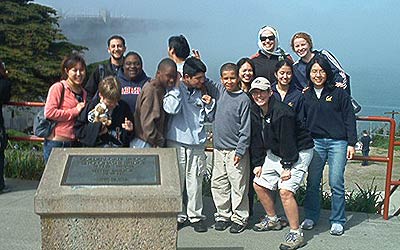 |
During their Alternative Break, students accompanied a group of adolescents with disabilities on a tour of San Francisco. (Photos courtesy of Alt. Break participants) |
UC Berkeley students give up their Spring Breaks, but get a lot back
BERKELEY – The most memorable moment of Chen Yeng's Spring Break was meeting a woman who'd recently moved to San Diego so her husband could start a new job laying tile. In his first week of work, he severed several fingers in an accident. One unfortunate event had led to another until the couple were homeless.
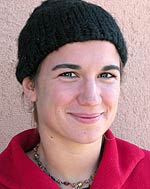 'I love to travel, and when I travel, I prefer to make it meaningful. It's not just that I want to help others - I get a whole lot out of it.' —Anna Oursler, fourth-year student |
"A month ago she was leading a more or less normal life, then because of this accident, she was forced to beg for food," says Yeng, a UC Berkeley freshman volunteering at a homeless shelter. "It was scary. I saw how easily it can be for people to end up homeless."
Yeng was among the 86 UC Berkeley students who chose to spend their week off, from March 22 to March 26, on an Alternative Break. Instead of sleeping in, socializing, or working on their tans, these students went on one of six Alternative Breaks sponsored by the Cal Corps Public Service Center. Ranging in size from 8 to 18 students, the groups worked with the homeless population of San Diego; with Bay Area people with disabilities; with conventional and organic farms in the Bay Area; with Sacramento teens on issues of depression, sexual health, and substance abuse; with environmental organizations in Tijuana, Mexico; and Mexico-California border groups on immigration, sweatshop, and humanitarian-relief issues.
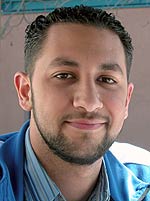 'At UC Berkeley, everyone is looking so far into the future, but when you work with people who are disabled, you think more about just putting one foot in front of the other.' —Ahmed Erakat, second-year student |
The Alternative Breaks program, now in its fourth year, is entirely organized and led by students. It's not something you decide to do on a whim when your Bahamas plans fall through. Students must sign up for a one-credit DeCal course, taught by one or two Alternative Breaks student leaders, that exposes them to the issues underlying their particular mission and involves "getting their feet wet with a couple of field trips," says Anna Oursler, the Spring Coordinator for Alternative Breaks. Those looking for an easy credit tend to drop the class before they have to put down a $100 deposit to secure their place on a break. With help from Cal Corps and fund-raising activities, that $100 will cover each student's transportation, food, and lodging for the break.
Oursler, a fourth-year landscape architecture major, has been involved with Alternative Breaks since its very first trip in 2001 in which students followed in the steps of activist Cesar Chavez. They worked alongside migrant workers in the fields of the Delta region and Delano, renovated their housing, and learned about the community's concerns. Oursler has led numerous winter, spring, and weekend breaks around environmental issues since then.
Asked when her last non-service break was, she can't even remember. "I love to travel, and when I travel, I prefer to make it meaningful," she shrugs. "It's not just that I want to help others - I get a whole lot out of it. When you volunteer in a community and share people's lives, even briefly, you learn so much more than if you just visit as a tourist. I feel like I walk away with so much more from these communities than I've given to them."
 Alternative Breakers laying a drip irrigation system for the People's Grocery urban gardens in Oakland … |
|
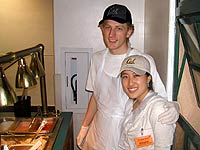 serving lunch in a San Diego soup kitchen … |
|
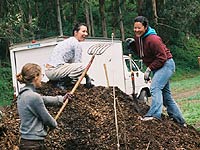 spreading organic mulch at the Green Gulch Zen Center … |
|
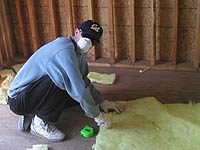 installing insulation in a Habitat for Humanity house … |
|
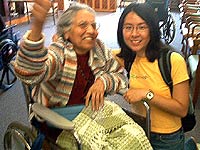 … and helping seniors get out to a play. |
Getting ready for the 2004 Alternative Spring Break started last August, when Oursler began teaching a DeCal class for prospective team leaders. Several had never been on an Alternative Break before or spent much time volunteering. With her help, they identified what issues were meaningful to them, then brainstormed about how to build a Spring Break that would examine their chosen issue from a variety of perspectives, contacting various organizations, nonprofits, and educational groups. Oursler estimates that team leaders spent more than 200 hours since August planning and organizing the breaks.
Ahmed Erakat, one of the student leaders of the "Appreciating Life: Understanding, Embracing, and Serving People with Disabilities" break, chose the title from past experience. Erakat, who is a second-year Religious Studies major "on a premed path," had a rocky first year at Berkeley. Always a good student, he was taken aback by the academic pressure and fierce competitiveness. Then, thanks to aimlessly surfing UC Berkeley's Careers website, he ended up spending last summer working as a counselor at Camp Krem, a camp for children and adults with disabilities of all kinds.
"At UC Berkeley, everyone is looking so far into the future - thinking about medical school, their career goals, whatever - but when you work with people who are disabled, you think more about just putting one foot in front of the other," says Erakat. "Going into it, I thought I would be giving so much of myself: changing diapers, helping people shower, being on call 24/7. Afterward I realized that I gained so much more from them than they did from me. It was the best summer of my life. I came back to school and worried less, and smiled a lot more."
For this year's Spring Break, Erakat and co-leader Sharon Hung immersed eight other students in the daily lives of people with disabilities around the Bay Area. They took a group from Camp Krem on a tour of San Francisco's tourist sites, including the Golden Gate Bridge. They accompanied wheelchair-bound residents of Chaparral House, an elderly residential center, on Paratransit - the shuttle service for seniors and people with disabilities - to a local play. "That was pretty eye-opening," says Erakat. "A lot of the seniors were scared by the ride."
Other "Appreciating Life' Spring Break activities included visiting a residential center for adults with violent tendencies as well as disabilities, a trip to the Guide Dogs for the Blind training facility in San Rafael, and a sobering day with Step by Step, a therapy program for children under 11 who have motor disabilities associated with cerebral palsy.
"Some children couldn't move at all, yet they were still smiling," recounts Erakat. "Others were working really hard just to move one of their feet. It puts a lot in perspective."
As did "Daily Life In the Streets of San Diego," the Alternative Break led by students Jessica Lee and Charlie Wang. This group learned about issues affecting the homeless by working in soup kitchens of various charity groups, building houses through Habits for Humanity, touring homeless facilities, and accompanying a case worker as she evaluated her homeless clients' needs. At night, they slept on the floor of various churches.
It was the first Alternative Break for Lee, a first-year student intending to major in business and social welfare. Lee is from San Diego, but until she started thinking about what issue to build her break around, she was unaware that San Diego County has the largest homeless population in the United States.
"I realized there was a lot I didn't know about this issue," says Lee. "Before we can do something about it, we have to understand it, and that's what I was trying to do."
|
Damian Moxhan, a second-year exchange student from Durham, England, was also searching for understanding. His father visited him in the fall, and on trips to San Francisco they were both struck by the number of homeless people. They talked to a few of them about how they came to be living on the streets. "It's not something you really see in England, because our climate is harsher and our social net stronger," says Moxhan. "I wanted to know how this could happen to so many people. And what I learned is that it can happen to anyone."
Moxhan adds that the experience has brought new resonance to his studies. A classics major, he had just finished reading "Oedipus Rex." By the end of the Sophocles play, the once-mighty King Oedipus has become a blind beggar. "The last line is 'Count no man happy till he dies, free of pain at last.' That kept popping into my head all break," says Moxhan.
Many of the Alternative Spring Breakers reported encountering incredulity that this is how they were spending their spring breaks. "A lot of people asked us, 'What are you doing here? You could be partying!'" recalls Javier Mendez, a second-year American studies major who participated in the San Diego homeless program. "I had to explain that I wanted to do something more meaningful with my Spring Break."
And does he feel that he did? "Definitely," says Mendez. "One week of volunteer work is not going to solve the problem, but it definitely opens your eyes to how big it is, and that's a start."
More information


